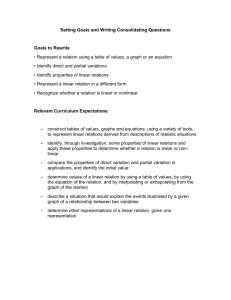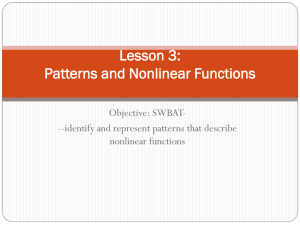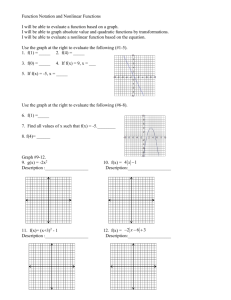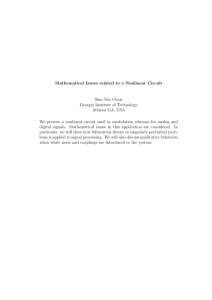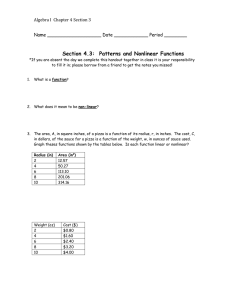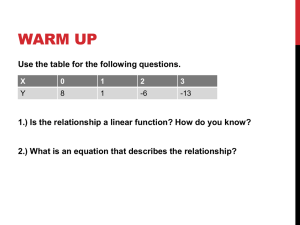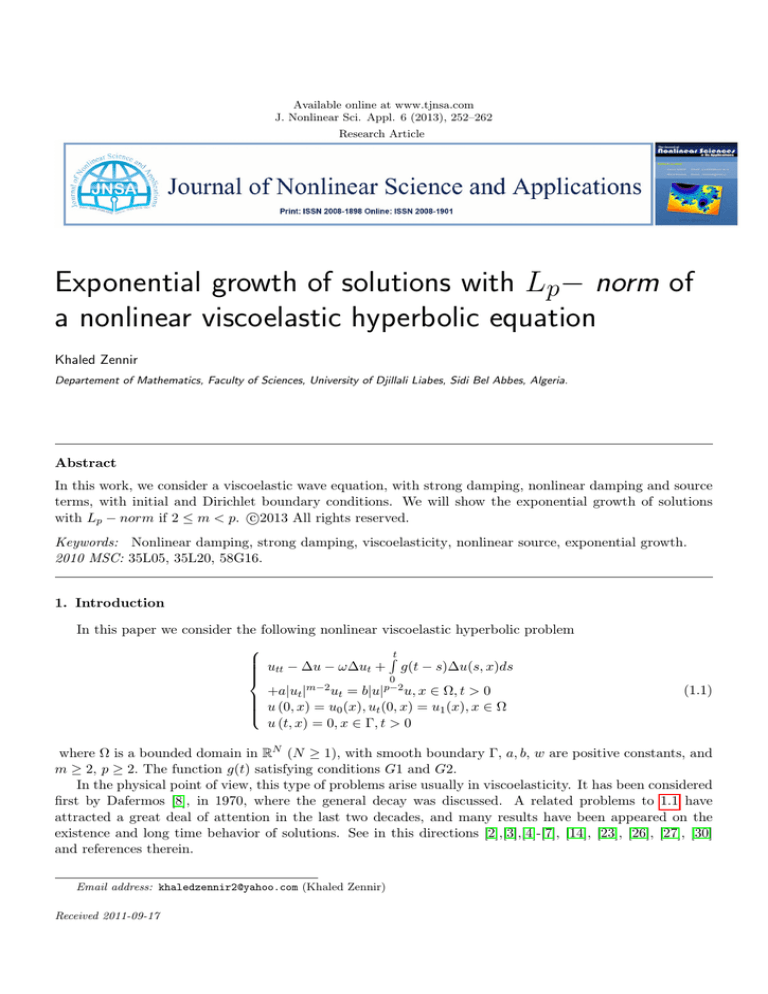
Available online at www.tjnsa.com
J. Nonlinear Sci. Appl. 6 (2013), 252–262
Research Article
Exponential growth of solutions with Lp− norm of
a nonlinear viscoelastic hyperbolic equation
Khaled Zennir
Departement of Mathematics, Faculty of Sciences, University of Djillali Liabes, Sidi Bel Abbes, Algeria.
Abstract
In this work, we consider a viscoelastic wave equation, with strong damping, nonlinear damping and source
terms, with initial and Dirichlet boundary conditions. We will show the exponential growth of solutions
c
with Lp − norm if 2 ≤ m < p. 2013
All rights reserved.
Keywords: Nonlinear damping, strong damping, viscoelasticity, nonlinear source, exponential growth.
2010 MSC: 35L05, 35L20, 58G16.
1. Introduction
In this paper we consider the following nonlinear viscoelastic hyperbolic problem
Rt
u
−
∆u
−
ω∆u
+
g(t − s)∆u(s, x)ds
tt
t
0
+a|ut |m−2 ut = b|u|p−2 u, x ∈ Ω, t > 0
u (0, x) = u0 (x), ut (0, x) = u1 (x), x ∈ Ω
u (t, x) = 0, x ∈ Γ, t > 0
(1.1)
where Ω is a bounded domain in RN (N ≥ 1), with smooth boundary Γ, a, b, w are positive constants, and
m ≥ 2, p ≥ 2. The function g(t) satisfying conditions G1 and G2.
In the physical point of view, this type of problems arise usually in viscoelasticity. It has been considered
first by Dafermos [8], in 1970, where the general decay was discussed. A related problems to 1.1 have
attracted a great deal of attention in the last two decades, and many results have been appeared on the
existence and long time behavior of solutions. See in this directions [2],[3],[4]-[7], [14], [23], [26], [27], [30]
and references therein.
Email address: khaledzennir2@yahoo.com (Khaled Zennir)
Received 2011-09-17
Khaled Zennir, J. Nonlinear Sci. Appl. 6 (2013), 252–262
253
In the absence of the strong damping ∆ut , that is for w = 0, and when the function g vanishes identically (
i.e. g = 0 ), then problem 1.1 reduced to the following initial boundary damped wave equation with nonlinear
damping and nonlinear sources terms.
utt − ∆u + a |ut |m−2 ut = b |u|p−2 u.
(1.2)
Some special cases of equation 1.2 arise in quantum field theory which describe the motion of charged
mesons in an electromagnetic field.
Equation 1.2 together with initial and boundary conditions of Dirichlet type, has been extensively studied
and results concerning existence, blow up and asymptotic behavior of smooth, as well as weak solutions have
been established by several authors.
For b = 0, that is in the absence of the source term, it is well known that the damping term a |ut |m−2 ut
assures global existence and decay of the solution energy for arbitrary initial data ( see [13] and [17]).
For a = 0, the source term causes finite-time blow-up of solutions with a large initial data ( negative
initial energy). That is to say, the norm of our solution u(t, x) in the energy space reaches +∞ when the
time t approaches certain value T ∗ called ” the blow up time”, ( see [1] and [16] for more details).
The interaction between the damping term a |ut |m−2 ut and the source term b |u|p−2 u makes the problem
more interesting. This situation was first considered by Levine [19]-[20] in the linear damping case (m = 2),
where he showed that solutions with negative initial energy blow up in finite time T ∗ . The main ingredient
used in [19] and [20] is the ” concavity method” where the basic idea of this method is to construct a positive
function L(t) of the solution and show that for some γ > 0, the function L−γ (t) is a positive concave function
of t.
Georgiev and Todorova in their famous paper [10], extended Levine’s result to the nonlinear damping
case (m > 2). More precisely, in [10] and by combining the Galerkin approximation with the contraction
mapping theorem, the authors showed that problem 1.2 in a bounded domain Ω with initial and boundary
conditions of Dirichlet type has a unique solution in the interval [0, T ) provided that T is small enough.
Also, they proved that the obtained solutions continue to exist globally in time if m ≥ p and the initial data
are small enough. Whereas for p > m the unique solution of problem 1.2 blows up in finite time provided
that the initial data are large enough. ( i.e. the initial energy is sufficiently negative).
This later result has been pushed by Messaoudi in [28] to the situation where the initial energy E(0) < 0.
For more general result in this direction, we refer the interested reader to the works of Vitillaro [35], Levine
[21] and [25].
In the presence of the viscoelastic term (g 6= 0) and for w = 0, our problem 1.1 becomes
Rt
u
−
∆u
+
g(t − s)∆u(s, x)ds
tt
0
(1.3)
+a|ut |m−2 ut = b|u|p−2 u, x ∈ Ω, t > 0
u(0, x) = u0 (x), ut (0, x) = u1 (x), x ∈ Ω
u(t, x) = 0, x ∈ Γ, t > 0
For a = 0, problem 1.3 has been investigated by Berrimi and Messaoudi [3]. They established the local
existence result by using the Galerkin method together with the contraction mapping theorem. Also, they
showed that for a suitable initial data, then the local solution is global in time and in addition, they showed
that the dissipation given by the viscoelastic integral term is strong enough to stabilize the oscillations of
the solution with the same rate of decaying ( exponential or polynomial) of the kernel g. Also their result has
been obtained under weaker conditions than those used by Cavalcanti et al [6], in which a similar problem
has been addressed.
Messaoudi in [23], showed that under appropriate conditions between m, p and g a blow up and global
existence result, of course his work generalizes the results by Georgiev and Todorova [10] and Messaoudi
[23].
One of the main direction of the research in this field seems to find the minimal dissipation such that the
solutions of problems similar to 1.3 decay uniformly to zero, as time goes to infinity. Consequently, several
Khaled Zennir, J. Nonlinear Sci. Appl. 6 (2013), 252–262
254
authors introduced different types of dissipative mechanisms to stabilize these problems. For example, a
localized frictional linear damping of the form a(x)ut acting in sub-domain w ⊂ Ω has been considered by
Cavalcanti et al [6]. More precisely the authors in [5] looked into the following problem
Zt
utt − ∆u +
g(t − s)∆u(s, x)ds + a(x)ut + |u|γ u = 0.
(1.4)
0
for γ > 0, g a positive function and a : Ω → R+ a function, which may be null on a part of the domain Ω.
By assuming a(x) ≥ a0 > 0 on the sub-domain w ⊂ Ω, the authors showed a decay result of an
exponential rate, provided that the kernel g satisfies
− ζ1 g(t) ≤ g 0 (t) ≤ −ζ2 g(t), t ≥ 0,
(1.5)
and kgkL1 (0,∞) is small enough.
This later result has been improved by Berrimi and Messaoudi [2], in which they showed that the
viscoelastic dissipation alone is strong enough to stabilize the problem even with an exponential rate.
In many existing works on this field, the following conditions on the kernel
g 0 (t) ≤ −ζg p (t), t ≥ 0, p ≥ 1,
(1.6)
is crucial in the proof of the stability.
For a viscoelastic systems with oscillating kernels, we mention the work by Rivera et al [29]. In that
work the authors proved that if the kernel satisfies g(0) > 0 and decays exponentially to zero, that is for
p = 1 in 1.6, then the solution also decays exponentially to zero. On the other hand, if the kernel decays
polynomially, i.e. (p > 1) in the inequality 1.6, then the solution also decays polynomially with the same
rate of decay.
In the presence of the strong damping (w > 0) and in the absence of the viscoelastic term (g = 0), the
problem (1) takes the following form
utt − ∆u − ω∆ut + a|ut |m−2 ut = b|u|p−2 u, x ∈ Ω, t > 0
u(0, x) = u0 (x), ut (0, x) = u1 (x), x ∈ Ω
(1.7)
u(t, x) = 0, x ∈ Γ, t > 0
Problem 1.7 represents the wave equation with a strong damping ∆ut . When m = 2, this problem has
been studied by Gazzola and Squassina [9]. In their work, the authors proved some results on well posedness
and asymptotic behavior of solutions. They showed the global existence and polynomial decay property of
solutions provided that the initial data is in the potential well.
The proof in [9] is based on a method used in [15]. Unfortunately their decay rate is not optimal, and
their result has been improved by Gerbi and Said-Houari [12], by using an appropriate modification of the
energy method and some differential and integral inequalities.
Introducing a strong damping term ∆ut makes the problem from that considered in [10], for this reason
less results where known for the wave equation with strong damping and many problem remain unsolved. (
See [9] and [11]).
In this article, we investigated problem 1.1, in which all the damping mechanism have been considered
in the same time ( i.e. w > 0, g 6= 0, and m ≥ 2), these assumptions make our problem different form
those studied in the literature, specially the exponential growth of solutions. We will prove that if the initial
energy E(0) of our solutions is negative ( this means that our initial data are large enough), then our local
solutions in bounded and
kut k2 + k∇uk2 → ∞
(1.8)
as t tends to +∞. In fact it will be proved that the Lp −norm of the solution grows as an exponential function.
An essential tool of the proof is an idea used in [11], which based on an auxiliary function (which is a small
Khaled Zennir, J. Nonlinear Sci. Appl. 6 (2013), 252–262
255
perturbation of the total energy), in order to obtain a differential inequality leads to the exponential growth
result provided that the following conditions
Z∞
g(s)ds <
p−2
,
p−1
(1.9)
0
holds.
2. Assumptions, Notations and Preliminaries
We consider a viscoelastic wave equation, with strong damping, polynomial nonlinear damping and
source term. Namely we looked into the following problem
Zt
utt − ∆u − ω∆ut +
g(t − s)∆u(s, x)ds + a|ut |m−2 ut = b|u|p−2 u, x ∈ Ω, t > 0
(2.1)
0
subjected to the following initial and boundary conditions
u(0, x) = u0 (x), ut (0, x) = u1 (x), x ∈ Ω
(2.2)
u(t, x) = 0, x ∈ Γ, t > 0
(2.3)
where Ω is a bounded domain in RN (N ≥ 1), with smooth boundary Γ, and a, b, w are positive constants,
m ≥ 2, p ≥ 2, and g is a nonnegative nonincreasing function. This type of problems are not only important
from the theoretical point of view, but also arise in many physical applications and describe a great deal of
models in applied science. One of the most important field of such problems arise in the models of nonlinear
viscoelasticity. Many authors studied these types of problems, and several results appeared in the literature.
The energy related to problem 1.1 is
1
E(t) = kut (t)k22 + J(t),
2
where
J(t) =
1
1−
2
Zt
(2.4)
1
b
g(s)ds k∇u(t)k22 + (g ◦ ∇u)(t) − ku(t)kpp ,
2
p
(2.5)
0
We assume that the kernel g satisfies the following conditions:
(G1) g : R+ −→ R+ is a bounded C 1 -function such that
Z∞
g(0) > 0, 1 −
g(s)ds = l > 0.
(2.6)
0
(G2) g(t) ≥ 0, g 0 (t) ≤ 0, g(t) ≤ −ξg 0 (t), ∀t ≥ 0.
Let us denote by
Zt
Z
(g ◦ u)(t) = g(t − s) |u(s) − u(t)|2 dxds.
0
(2.7)
Ω
The goal of this work is the study of the Exponential Growth of the problem 1.1. We first state a local
existence theorem that can be established by combining arguments of Georgiev and Todorova [10]. In fact
this depends on the parameters values of the coefficients and the exponents m and p. Let us introduce the
following complete metric space
u : u ∈ C [0, T ]; H01 (Ω) ,
YT =
.
(2.8)
ut ∈ C [0, T ]; H01 (Ω) ∩ Lm ([0, T ] × Ω)
Khaled Zennir, J. Nonlinear Sci. Appl. 6 (2013), 252–262
256
2
Theorem 2.1. Let (u0 , u1 ) ∈ H01 (Ω) be given. Suppose that m ≥ 2, p ≥ 2 be such that
max m, p ≤
2(n − 1)
, n ≥ 3.
n−2
(2.9)
Then, under the conditions (G1) and (G2), the problem 1.1 has a unique local solution u(t, x) ∈ YT , for T
small enough.
The following technical lemma will play an important role in the sequel.
Lemma 2.2. [5] For any v ∈ C 1 0, T ; H 2 (Ω) we have
t
Z
Z
Z Zt
1d
1d
g(s) |∇v(t)|2 dxds
(g ◦ ∇v)(t) −
g(t − s)∆v(s).v 0 (t)dsdx =
2 dt
2 dt
0
Ω
Ω 0
Z
1 0
1
− g ◦ ∇v (t) + g(t) |∇v(t)|2 dx.
2
2
Ω
In the next theorem we give the global existence result, its proof based on the potential well depth
method in which the concept of so-called stable set appears, where we show that if we restrict our initial
data in the stable set, then our local solution obtained is global in time, that is to say, the norm
kut k2 + k∇uk2 ,
(2.10)
in the energy space L2 (Ω) × H01 (Ω) of our solution is bounded by a constant independent of the time t. We
will make use of arguments in [33].
Theorem 2.3. Suppose that (G1), (G2) and 2.9 hold. if u0 ∈ W, u1 ∈ H01 (Ω) and
bC∗p
l
2p
E(0)
(p − 2)l
p−2
2
< 1,
(2.11)
where C∗ is the best Poincaré’s constant. Then the local solution u(t, x) is global in time.
Remark 2.4. Let us remark, that if there exists t0 ∈ [0, T ) such that u(t0 ) ∈ W and ut (t0 ) ∈ H01 (Ω) and
condition 2.11 holds for t0 . Then the same result of theorem 2.3 stays true.
3. Main results
Our result reads as follows.
2(n − 1)
Theorem 3.1. Suppose that m ≥ 2 and m < p ≤ ∞, if n = 1, 2, m < p ≤
, if n ≥ 3. Assume
n−2
∞
R
p−2
further that E(0) < 0 and g(s)ds <
holds. Then the unique local solution of problem 1.1 grows
p−1
0
exponentially.
Proof. We set
H(t) = −E(t).
(3.1)
By multiplying the first equations in 1.1 by −ut , integrating over Ω, we obtain
Zt
d 1
1
1
b
−
kut k22 + 1 − g(s)ds k∇uk22 + (g ◦ ∇u) (t) − kukpp
dt 2
2
2
p
0
1 0
1
2
2
= akut km
m − (g ◦ ∇u)(t) + g(t)k∇uk2 + wk∇ut k2 .
2
2
(3.2)
Khaled Zennir, J. Nonlinear Sci. Appl. 6 (2013), 252–262
257
By the definition of H(t), 3.2 rewritten as
H 0 (t) = akut km
m−
1 0
1
g ◦ ∇u (t) + g(t)k∇uk22 + wk∇ut k22 ≥ 0, ∀t ≥ 0.
2
2
(3.3)
Consequently, E(0) < 0, we have
1
1
b
H(0) = − ku1 k22 − k∇u0 k22 + ku0 kpp > 0.
2
2
p
(3.4)
It’s clear that by 3.1, we have
H(0) ≤ H(t), ∀t ≥ 0.
(3.5)
Using (G2), to get
b
1
1
H(t) − kukpp = − kut k22 + 1 −
p
2
2
Zt
g(s)ds k∇uk22 +
1
(g ◦ ∇u) (t)
2
0
≤ 0, ∀t ≥ 0.
(3.6)
One implies
0 < H(0) ≤ H(t) ≤
b
kukpp .
p
(3.7)
Let us define the functional
Z
L(t) = H(t) + ε
w
ut udx + ε k∇uk22 .
2
(3.8)
Ω
for ε small to be chosen later.
By taking the time derivative of 3.8, we obtain
Z
Z
0
0
2
L (t) = H (t) + ε uutt (t, x)dx + εkut k2 + εw ∇ut ∇udx
Ω
Ω
1
1 0
= wk∇ut k22 + akut km
g ◦ ∇u (t) + g(t)k∇uk22
m−
2
2
Z
Z
2
+εkut k2 + εw ∇ut ∇udx + ε utt udx.
Ω
(3.9)
Ω
Using the first equations in 1.1, to obtain
Z
Z
Z
p
2
uutt dx = bkukp − k∇uk2 − ω ∇ut ∇udx − a |ut |m−2 ut udx
Ω
Ω
∇u
+
Ω
Ω
Zt
Z
g(t − s)∇u(s, x)dsdx.
(3.10)
0
Inserting 3.10 into 3.9 to get
1
1 0
2
L0 (t) = wk∇ut k22 + akut km
m − (g ◦ ∇u)(t) + g(t)k∇uk2
2
2
Zt
Z
2
2
+εkut k2 − εk∇uk2 + ε g(t − s) ∇u.∇u(s)dxds
0
+εbkukpp − εa
Z
Ω
|ut |m−2 ut udx.
Ω
(3.11)
Khaled Zennir, J. Nonlinear Sci. Appl. 6 (2013), 252–262
258
By using (G2), the last equality takes the form
2
2
p
L0 (t) ≥ wk∇ut k22 + akut km
m + εkut k2 − εk∇uk2 + εbkukp
Zt
∇u.∇u(s)dxds − εa
g(t − s)
+ε
Z
Z
0
|ut |m−2 ut udσ.
(3.12)
Ω
Ω
To estimate the last term in the right-hand side of 3.12, we use the following Young’s inequality
XY ≤
δ r r δ −q q
X +
Y , X, Y ≥ 0,
r
q
(3.13)
m
1 1
+ = 1, with r = m and q =
.
r q
m−1
for all δ > 0 be chosen later,
So we have
Z
Z
m−2
|ut |m−1 |u|dx
|ut |
ut udx ≤
Ω
Ω
δm
kukm
m+
m
≤
m−1
m
−m
δ ( m−1 ) kut km
m , ∀t ≥ 0.
(3.14)
Therefore, the estimate 3.12 takes the form
2
2
p
L0 (t) ≥ wk∇ut k22 + akut km
m + εkut k2 − εk∇uk2 + εbkukp
Zt
Z
g(t − s)
+ε
0
∇u.∇u(s)dxds
Ω
−m
δm
m − 1 ( m−1
)
−εa kukm
)δ
kut km
m − εa(
m
m
m
2
m
2
≥ wk∇ut k2 + akut km + εkut k2 − εk∇uk22 + εbkukpp
+εk∇uk22
Zt
Z
g(t − s)
g(s)ds + ε
0
δm
Zt
∇u(t) [∇u(s) − ∇u(t)] dxds
0
Ω
−m
1 ( m−1 )
kut km
)δ
m.
m−
kukm
m − εa(
m
m
Using Cauchy-Schwarz and Young’s inequalities to obtain
−m m−1
0
2
2
kut km
L (t) ≥ wk∇ut k2 + a 1 − ε
δ m−1
m + εkut k2
m
Zt
2
p
2
−εk∇uk2 + εbkukp + εk∇uk2 g(s)ds
−εa
0
Zt
−ε
g(t − s)k∇uk2 k∇u(s) − ∇u(t)k2 ds − εa
δm
kukm
m
m
0
−m m−1
2
p
≥
+a 1−ε
δ m−1
kut km
m + εkut k2 + εbkukp
m
t
Z
1
1
δm
g(s)ds − 1 k∇uk22 − ε (g ◦ ∇u(t)) − εa kukm
+ε
m.
2
2
m
wk∇ut k22
0
(3.15)
(3.16)
Khaled Zennir, J. Nonlinear Sci. Appl. 6 (2013), 252–262
259
Using assumptions to substitute for bkukpp . Hence, 3.16 becomes
−m m−1
0
2
2
L (t) ≥ wk∇ut k2 + a 1 − ε
δ m−1
kut km
m + εkut k2
m
Zt
p
p
p
+ε pH(t) + kut k22 + (g ◦ ∇u) (t) + 1 − g(s)ds k∇uk22
2
2
2
0
t
Z
1
1
δm
g(s)ds − 1 k∇uk22 − ε (g ◦ ∇u(t)) − εa kukm
(3.17)
+ε
m.
2
2
m
0
−m m−1
p
2
≥ wk∇ut k2 + a 1 − ε
δ m−1
kut km
kut k22
m+ε 1+
m
2
δm
+εa1 k∇uk22 + εa2 (g ◦ ∇u(t) − εa kukm
m + εpH(t).
m
1 − p R∞
p−2
p−1
where a1 = (
) g(s)ds + (
) > 0, a2 =
> 0.
2
2
2
0
In order to undervalue L0 (t) with terms of E(t) and since p > m, we have from the embedding Lp (Ω) ,→
m
L (Ω),
m
m
p p
, ∀t ≥ 0.
(3.18)
kukm
m ≤ Ckukp ≤ C kukp
for some positive constant C depending on Ω only. Since 0 <
m
< 1, as in [11] we use the algebraic
p
inequality
1
z ≤ (z + 1) ≤ 1 +
(z + w), ∀z ≥ 0, 0 < k ≤ 1, w > 0,
w
k
to find
kukpp
where K = 1 +
m
p
≤ K kukpp + H(0) , ∀t ≥ 0,
(3.19)
(3.20)
1
> 0, then by 3.7 we have
H(0)
kukm
m
b
≤C 1+
kukpp , ∀t ≥ 0.
p
(3.21)
Inserting 3.21 into 3.17, to get
−m m−1
p
0
2
L (t) ≥ wk∇ut k2 + a 1 − ε
δ m−1
kut km
kut k22
m+ε 1+
m
2
+εa1 k∇uk22 + εa2 (g ◦ ∇u)(t) − εC1 kukpp + εpH(t).
δm
b
where C1 = aC
1+
> 0.
m
p
By using 3.1 and by the same statements as in [12], we have
2H(t) =
−kut k22
≥
−kut k22
−
k∇uk22
−
k∇uk22
Zt
+
g(s)dsk∇uk22 − (g ◦ ∇u) (t) +
0
− (g ◦ ∇u) (t) +
2b
kukpp , ∀t ≥ 0.
p
(3.22)
2b
kukpp
p
Khaled Zennir, J. Nonlinear Sci. Appl. 6 (2013), 252–262
260
Adding and substituting the value 2a3 H(t) from 3.22, and choosing δ small enough such that a3 < min a1 , a2 ,
we obtain
−m m−1
0
2
L (t) ≥ wk∇ut k2 + a 1 − ε
δ m−1
kut km
m
m
p
+ε 1 + − a3 kut k22 + ε (a1 − a3 ) k∇uk22
2
2b
a3 − C1 kukpp
+ε (a2 − a3 ) (g ◦ ∇u)(t) + ε
p
+ε (p − 2a3 ) H(t).
(3.23)
Now, once δ is fixed, we can choose ε small enough such that
−m m−1
1−ε
δ m−1 > 0, and L(0) > 0.
m
(3.24)
Therefore, 3.23 takes the form
L0 (t) ≥ εθ H(t) + kut k22 + k∇uk22 + (g ◦ ∇u(t)) + kukpp ,
for some θ > 0.
Now, using (G2), Young’s and Poincaré’s inequalities in 3.8 to get
L(t) ≤ θ1 H(t) + kut k22 + k∇uk22 ,
for some θ1 > 0. Since, H(t) > 0, we have from 3.1
Zt
1
1
b
1
− kut k22 − 1 − g(s)ds k∇uk22 − (g ◦ ∇u) (t) + kukpp > 0, ∀t ≥ 0.
2
2
2
p
(3.25)
(3.26)
(3.27)
0
Then,
1
1−
2
Zt
g(s)ds k∇uk22 <
b
b
kukpp < kukpp + (g ◦ ∇u) (t).
p
p
(3.28)
0
In the other hand, using (G1), to get
Zt
1
1
b
(1 − l) k∇uk22 ≤ 1 − g(s)ds k∇uk22 < kukpp + (g ◦ ∇u) (t).
2
2
p
(3.29)
0
Consequently,
k∇uk22 <
2b
kukpp + 2 (g ◦ ∇u) (t) + 2lk∇uk22 , b, l > 0.
p
Inserting 3.30 into 3.26, to see that there exists a positive constant λ such that
b
p
2
2
L(t) ≤ λ H(t) + kut k2 + k∇uk2 + (g ◦ ∇u)(t) + kukp , ∀t ≥ 0.
p
(3.30)
(3.31)
From inequalities 3.25 and 3.31 we obtain the differential inequality
L0 (t)
≥ µ, for some, µ > 0, ∀t ≥ 0.
L(t)
(3.32)
Khaled Zennir, J. Nonlinear Sci. Appl. 6 (2013), 252–262
261
Integration of 3.32, between 0 and t gives us
L(t) ≥ L(0) exp(µt), ∀t ≥ 0,
(3.33)
From 3.8 and for ε small enough, we have
L(t) ≤ H(t) ≤
b
kukpp .
p
(3.34)
By 3.33 and 3.34, we have
kukpp ≥ C exp(µt), C > 0, ∀t ≥ 0.
(3.35)
Therefore, we conclude that the solution in the Lp −norm growths exponentially.
Acknowledgements:
The author is grateful to referee for his/her valuable suggestions which improved this paper.
References
[1] J. Ball, Remarks on blow up and nonexistence theorems for nonlinear evolutions equations, Quart. J. Math.
Oxford, 28 (1977), 473–486. 1
[2] S. Berrimi, S. Messaoudi, Exponential decay of solutions to a viscoelastic equation with nonlinear localized damping, Electronic journal of differential equations, 88 (2004), 1–10. 1, 1
[3] S. Berrimi, S. Messaoudi, Existence and decay of solutions of a viscoelastic equation with a nonlinear source,
Nonlinear Analysis, 64 ( 2006), 2314–2331. 1, 1
[4] M. M. Cavalcanti, V. N. D. Calvalcanti, J. A. Soriano, Exponential decay for the solutions of semilinear viscoelastic
wave equations with localized damping , Electronic journal of differential equations, 44 (2002), 1–44. 1
[5] M. M. Cavalcanti, H. P. Oquendo, Frictional versus viscoelastic damping in a semilinear wave equation, SIAM
journal on control and optimization, 42 (2003), 1310–1324. 1, 2.2
[6] M. M. Cavalcanti, D. Cavalcanti, J. Ferreira, Existence and uniform decay for nonlinear viscoelastic equation
with strong damping, Math. Meth. Appl. Sci., 24 (2001), 1043–1053. 1
[7] M. M. Cavalcanti, D. Cavalcanti, P. J. S. Filho, J. A. Soriano, Existence and uniform decay rates for viscoelastic
problems with nonlinear boundary damping, Differential and integral equations, 14 (2001), 85–116. 1
[8] C. M. Dafermos, Asymptotic stability in viscoelasticity, Arch. Rational Mech. Anal, 37 (1970), 297–308. 1
[9] F. Gazzola, M. Sequassina, Global solution and finite time blow up for damped semilinear wave equation, Ann. I.
H. Pointcaré-An, 23 (2006), 185–207. 1
[10] V. Georgiev, G. Todorova, Existence of solution of the wave equation with nonlinear damping and source terms,
Journal of differential equations 109 (1994), 295–308. 1, 1, 1, 2
[11] S. Gerbi, B. Said-Houari, Local existence and exponential growth for a semilinear damped wave equation with
dynamic boundary conditions, Advances in Differential Equations, 13 (2008), 1051–1074. 1, 1, 3
[12] S. Gerbi, B. Said-Houari, Exponential decay for solutions to semilinear damped wave equation, Discrete and
Continuous Dynamical Systems, (2010). 1, 3
[13] A. Haraux, E. Zuazua, Decay estimates for some semilinear damped hyperbolic problems, Arch. Rational Mech.
Anal, 150 (1988), 191–206. 1
[14] W. J. Hrusa, M. Renardy, A model equation for viscoelasticity with a strongly singular kernel, SIAM J. Math.
Anal, 19 (1988), 19–28. 1
[15] R. Ikehata, Some remarks on the wave equations with nonlinear damping and source terms, Nonlinear Analysis,
27 (1996), 1165–1175. 1
[16] V. K. Kalantarov, O. A. Ladyzhenskaya , The occurrence of collapse for quasilinear equation of parabolic and
hyperbolic type, J. Soviet Math, 10 (1978), 53–70. 1
[17] M. Kopackova, Remarks on bounded solutions of a semilinear dissipative hyperbolic equation, Comment Math.
Univ. Carolin, 30 (1989), 713–719. 1
[18] H. A. Levine, S.R. Park, Global existence and global nonexistence of solutions of the Cauchy problem for nonlinear
damped wave equation, J. Math. Anal. Appl, 228 (1998), 181–205.
[19] H. A. Levine, Instability and nonexistence of global solutions of nonlinear wave equation of the form P utt =
Au + F (u), Trans. Amer. Math. Sci, 192 (1974), 1–21. 1
[20] H. A. Levine, Some additional remarks on the nonexistence of global solutions of nonlinear wave equation, SIAM
J. Math. Anal, 5 (1974), 138–146. 1
Khaled Zennir, J. Nonlinear Sci. Appl. 6 (2013), 252–262
262
[21] H. A. Levine, J. Serrin, A global nonexistence theorem for quasilinear evolution equation with dissipative, Arch.
Rational Mech Anal, 137 (1997), 341–361. 1
[22] J. L. Lions, ”quelques méthodes de résolution des problemes aux limites non lineaires”, Dunod, Gaulthier-Villars,
Paris (1969).
[23] S. Messaoudi, Blow up and global existence in a nonlinear viscoelastic wave equation, Maths Nachr, 260 ( 2003),
58–66. 1, 1
[24] S. Messaoudi, Blow up of positive-initial energy solutions of a nonlinear viscoelastic hyperbolic equation, J. Math.
Anal. Appl, 320 (2006), 902–915.
[25] S. Messaoudi, B. Said-Houari, Global nonexistence of solutions of a class of wave equations with nonlinear damping
and source terms, Math. Meth. Appl. Sc, 27 (2004), 1687–1696. 1
[26] S. Messaoudi, N-E. Tatar, Global existence and asymptotic behavior for a nonlinear viscoelastic problem, Mathematical. Sciences research journal, 7(4) (2003), 136–149. 1
[27] S. Messaoudi and N-E. Tatar, Global existence and uniform stability of a solutions for quasilinear viscoelastic
problem, Math. Meth. Appl. Sci, 30 (2007), 665–680. 1
[28] S. Messaoudi, Blow up in a nonlinearly damped wave equation, Math. Nachr., 231 (2001), 1–7. 1
[29] J. E. Munoz Rivera, M.G. Naso, On the decay of the energy for systems with memory and indefinite dissipation,
Asymptote. anal. 49 (34) (2006), pp. 189–204. 1
[30] Vi. Pata, Exponential stability in viscoelasticity, Quarterly of applied mathematics volume LXIV, number 3,
499–513, September (2006). 1
[31] J. E. M. Rivera, E. C. Lapa and R. K. Barreto, Decay rates for viscoelastic plates with memory, Journal of
elasticity, 44 (1996), 61–87.
[32] J. E. M. Rivera, R. K. Barreto, Decay rates of solutions to thermoviscoelastic plates with memory, IMA journal
of applied mathematics, 60 (1998), 263–283.
[33] Shun-Tang Wu, Long-Yi Tsai, On global existence and blow-up of solutions or an integro-differential equation
with strong damping, Taiwanese J. Math., 10 (2006), 979–1014. 2
[34] G. Todorova, Stable and unstable sets for the Cauchy problem for a nonlinear wave with nonlinear damping and
source terms, J. Math. Anal. Appl, 239 (1999), 213–226.
[35] E. Vittilaro, Global nonexistence theorems for a class of evolution equations with dissipation, Arch. Rational
Mech. Anal, 149 (1999), 155–182. 1
[36] E. Zuazua, Exponential decay for the semilinear wave equation with locally distributed damping, Comm. PDE, 15
(1990), 205–235.



